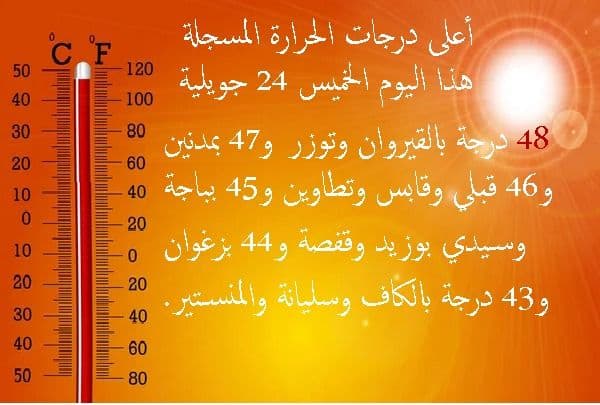When the Desert Speaks: Tunisia's Summer Weather and Its Unseen Dynamics
Explore Tunisia's summer weather beyond the forecast. Uncover the Shahili wind's secrets, regional heat impacts, and vital meteorological cooperation efforts.
The July Swelter: A Snapshot of Tunisia's Current Climate
As July unfolds, Tunisia steps further into the embrace of its characteristic summer heat, a season defined by more than just high temperatures. A closer look at the forecast for July 18, 2025, reveals a nuanced picture. While a slight increase in temperatures is anticipated across the board, the mercury isn't uniformly high nationwide. Coastal areas and highlands, benefiting from the moderating influence of the sea and elevation, are expected to see highs ranging from a warm 30 to 35 degrees Celsius. Venturing inland, however, the heat intensifies significantly, with most other regions bracing for temperatures between 36 and 41 degrees Celsius. The southwestern parts of the country, true to their desert proximity, are forecast to experience the most intense conditions, potentially reaching a scorching 43 degrees Celsius. Wind patterns also play a role, with a gentle to moderate northern flow dominating the north and central regions, while the south experiences westerly winds. These winds are predicted to strengthen near the eastern coasts later in the day, subtly shaping the feel of the heat and setting the stage for more localized phenomena.
Shahili's Embrace: Decoding the Desert Wind's Influence
The mention of temperatures soaring to 43 degrees Celsius in the southwest, accompanied by the localized appearance of 'Shahili,' introduces a critical element of Tunisia's summer weather narrative. Shahili isn't just any wind; it's a hot, dry, often dust-laden wind originating from the . As it sweeps across the arid interior, it undergoes adiabatic heating, meaning it warms further as it descends, arriving in regions like the with an intensified, parching heat. This phenomenon isn't constant across the entire country; its 'local appearance' suggests it's a specific, potent force that significantly amplifies the feeling of a heatwave in certain areas. It dries out the landscape, exacerbates the risk of wildfires, and can make outdoor activity particularly challenging. Understanding Shahili is key to grasping the true intensity of Tunisia's summer, moving beyond mere numerical temperature readings to appreciate the complex interplay of geography and atmospheric dynamics.
Navigating the Heat: Regional Impacts and Daily Life Adaptations
The varying temperature zones across Tunisia, especially when amplified by the Shahili, create distinct regional impacts that shape daily life. While coastal cities might enjoy a relatively 'mild' summer, albeit still hot, residents in the interior, particularly the southwest, face extreme conditions. This intense heat isn't just uncomfortable; it poses significant challenges, from agricultural stress to public health concerns. The recent news of controlling a forest fire in Rimal forest near Manzel Jamil serves as a stark reminder of the heightened risk of blazes during these periods, a direct consequence of parched landscapes and high temperatures. Communities across Tunisia have developed time-honored adaptations: seeking shade during peak hours, adjusting work schedules, and prioritizing hydration. Traditional architecture, with its thick walls and courtyards, also plays a vital role in passive cooling. Yet, as temperatures trend upwards, these adaptations are increasingly tested, demanding more proactive strategies to ensure well-being and environmental safety.
Beyond Borders: The Role of Meteorological Cooperation in a Changing Climate
Addressing the complexities of Tunisia's summer weather, particularly in an era of climate change, extends beyond national boundaries. Weather systems, like the Shahili, don't respect borders, making international collaboration in meteorology not just beneficial but essential. A significant step in this direction is Tunisia's recent ratification of a framework agreement with , focusing on cooperation in transport, logistics, and crucially, meteorology. This kind of partnership is invaluable. It facilitates the sharing of critical weather data, enhances forecasting accuracy for cross-border phenomena, and allows for coordinated responses to severe weather events, such as heatwaves or desert dust storms that can impact both nations. In a world where climate patterns are becoming increasingly unpredictable, fostering robust regional meteorological networks ensures that countries like have access to broader data sets and shared expertise, strengthening their collective resilience against the escalating challenges of a warming planet.
Forecasting Tomorrow: Preparing for Tunisia's Climatic Future
Looking ahead, Tunisia's summer weather patterns, influenced by both local phenomena like Shahili and broader climatic shifts, necessitate a forward-thinking approach to preparedness. The insights gleaned from daily forecasts, combined with the strategic value of international meteorological cooperation, form the bedrock of this readiness. What does this mean for Tunisia's climatic future? It implies a need for continuous investment in advanced forecasting technologies, allowing for more precise predictions of heatwaves and their potential impacts. It also points towards developing robust climate resilience strategies, from water management and agricultural innovations to public health campaigns that educate citizens on heat safety. Furthermore, strengthening regional partnerships, as seen with Algeria, will be paramount for anticipating and mitigating the effects of transboundary weather events. By integrating these elements, Tunisia can move beyond merely reacting to the summer swelter and instead proactively shape a more resilient future for its people and environment.
Related Articles

The Chehili Chronicles: Unveiling Tunisia's Extreme Heat Phenomena

The Chehili Chronicles: Unveiling Tunisia's Extreme Heat Phenomena

The Hidden Heat: Unmasking Egypt's Humid Summer and Adapting to the 'Felt' Reality

The Hidden Heat: Unmasking Egypt's Humid Summer and Adapting to the 'Felt' Reality

Under a Fervent Sky: Tozeur's Unprecedented Heat and the Shifting Sands of Climate Reality

Under a Fervent Sky: Tozeur's Unprecedented Heat and the Shifting Sands of Climate Reality

Rewriting the Rhythms: When Extreme Heat Becomes the New Normal
